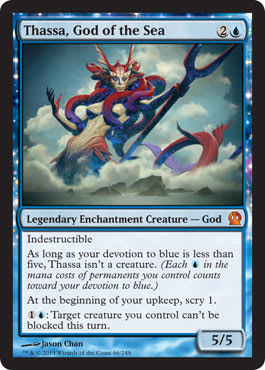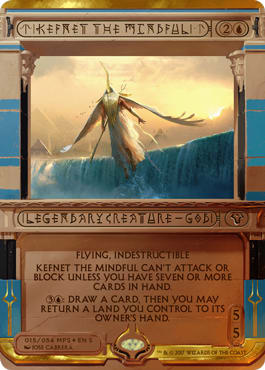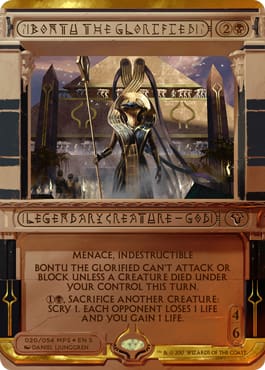The ability to draw comparisons between new cards and old cards is one of the most valuable tools we have as deck-builders. Instead of having to test 200+ cards every time a new set comes out, we can generally compress the amount of cards that actually matter down to a fraction of this. This is due, in large part, to our ability to look toward what has constituted a playable card in the past. And while these comparisons should never be taken too literally, as context is one of the most significant determinants in whether or not a card is a playable, a thorough analysis of both the raw power level of similar cards and the reason why they saw play can really expedite what would otherwise be an arduous testing process.
At first glance, the gods are some of the more tricky cards to evaluate from Amonkhet. But by using their Theros counterparts as an analog, we can get a basic understanding of: which gods are the best of the bunch, whether or not they’re poised to make an impact in Standard, and how to build decks incorporating them.
During their first go around, gods had a rather large impact on their respective format. Aside from Heliod, God of the Sun, each other one saw a healthy amount of play. Thassa, God of the Sea was one of the most dominant cards in its original format, and the others were essential roleplayers in dedicated devotion decks.
The new iteration of gods function similarly to the original ones. They’re undercosted and indestructible, but they require you to jump through some hoops in order to “activate” them. Since the new gods are similar in both power level and function to the old ones, it would safe to assume they’re going a see a decent amount of play. But as I mentioned earlier, it’s important to dig deeper than this.
One of the biggest takeaways from the Theros gods is the fact that they weren’t cards that could be played and activated incidentally. As someone who has cast way too many Frostburn Weirds, I can attest that you really had to work for them. The sacrifices you had to make in order to incorporate some of the gods proved to be worth it though, as the payoff was so high. But after the rotation of Return to Ravnica, we were shown there was a very real limit to this. Without hybrid mana creatures alongside them, the gods took a pretty big hit in the 2nd Standard format that they were legal in and saw almost no play. Due to the lack of color-intensive permanents in the format, activating the gods was far too difficult. From this, we can derive that how playable the Amonkhet gods are is contingent on how easy they are to activate.
Unlike their predecessors, the new gods all have different requirements and their activated abilities aid you in meeting their requirements. Because of this, there is a much wider range between the power levels of these gods. But taking what we know about them into account, we can get an idea of which gods are likely to have the biggest impact in Standard and what decks incorporating them should look like.
5) Kefnet the Mindful
On a rate alone, Kefnet is arguably the best of the bunch. Rate only accounts for so much though, and it has the steepest activation requirements of any god by a pretty large margin. Keeping a full grip is nearly impossible in Standard, as there are countless cheap permanents that demand interaction or else they just threaten to runaway with the game. I would predict that Kefnet’s chances of seeing play aren’t too high, but there is a pairing I’m pretty interested in. Kefnet works incredibly well with Fevered Visions. The enchantment provides you with a steady stream of cards to keep your Kefnet active, and the chip damage from it in combination with Kefnet’s hulking body can close a game out quite quickly.
Kenet Sample Deck ? Amonkhet Standard | Andrew Jessup
- Creatures (14)
- 2 Kefnet the Mindful
- 4 Enigma Drake
- 4 Glorybringer
- 4 Stormchaser Mage
- Instants (8)
- 4 Fiery Temper
- 4 Shock
- Sorceries (10)
- 2 Insult // Injury
- 4 Cathartic Reunion
- 4 Incendiary Flow
- Enchantments (4)
- 4 Fevered Visions
- Lands (24)
- 5 Island
- 9 Mountain
- 2 Sunscorched Desert
- 4 Spirebluff Canal
- 4 Wandering Fumarole
Decks centered around Fevered Visions have seen some moderate success in the past, but have yet to see any sustained success. Fortunately for fans of the archetype, Amonkhet offers a bunch of new tools. Kefnet slots in pretty well here especially with the transition to flying creature base. Powerful recursive damage sources have always been the key to making any deck that plans on burning the opponent out viable, and this decks has a lot of large evasive creatures that threaten to get through multiple times in a game.
Ignoring the gods for a moment, this is still a good chance to talk about other new cards as well. Enigma Drake is an interesting one as it has both a very high ceiling and a very low floor. In a deck playing as many spells as this one, it’s not rare for it to be a 4/4 flier by the time you start attacking with it. But you also risk having a 1/4 for three in your deck at some points. Overall, it’s likely to be a large and evasive beater enough of the time that it’s worth having it in the deck still.
I mentioned using precedent as a means of evaluating new cards earlier, and everything similar card in the past indicates Insult // Injury is a mediocre card, but I can’t stop myself from thinking the card is reasonable. It’s easy to imagine getting plenty of value out of the front half just by attacking with a flier and playing a Shock, and it’s a great card to pitch to Cathartic Reunion in this deck. I’m weirdly optimistic about this card being a good fit for this deck.
Glorybringer is the last new card in the deck, and there’s no too much to say about it that hasn’t already been said. I will add though that there has been a shakeup in my rankings from my last article and Glorybringer is almost certainly going to be the most impactful card out of Amonkhet.
4) Oketra the True
Oketra narrowly edged out Kefnet for the four slot. While active it’s not quite as good as Kefnet, but getting three creatures in play will often be easier than holding seven cards. With that being said, the three creature requirement is still the second most difficult to meet. And what made the decision between Kefnet and Oketra close is, the fact that Oketra’s activated ability is horrendous in comparison to the others. So the appeal of playing it, can be attributed solely to the fact that it’s a 3/6, Indestructible, double striker, for 4-mana. But obviously that’s still quite good, and worth putting some effort into to make it happen.
Oketra Sample Deck ? Amonkhet Standard| Andrew Jessup
- Creatures (20)
- 2 Manglehorn
- 2 Oketra the True
- 4 Archangel Avacyn
- 4 Channeler Initiate
- 4 Thraben Inspector
- 4 Walking Ballista
- Planeswalkers (8)
- 4 Gideon, Ally of Zendikar
- 4 Nissa, Voice of Zendikar
- Enchantments (8)
- 4 Cast Out
- 4 Oath of Nissa
- Lands (24)
- 7 Plains
- 9 Forest
- 4 Canopy Vista
- 4 Fortified Village
Oketra slots well into a ![]()
![]() tokens shell. The deck can easily clog up the ground with the token producing Planeswalkers, and put the opponent into the abyss by bashing with it repeatedly. It’s also a welcomed addition because the deck was in want of another four-drop with the addition of Channeler Initiate. And while Oketra is good, if this archetype sees a resurgence, it will likely be off the back of Channeler Initiate.
tokens shell. The deck can easily clog up the ground with the token producing Planeswalkers, and put the opponent into the abyss by bashing with it repeatedly. It’s also a welcomed addition because the deck was in want of another four-drop with the addition of Channeler Initiate. And while Oketra is good, if this archetype sees a resurgence, it will likely be off the back of Channeler Initiate.
How good Channeler Initiate is in this deck should not be understated. In the early game, it’s the perfect card to accelerate out your Gideons and Avacyns, and in the late game you can play it, pick off a token with counters, and flip your Avacyn with a 3/4 in play. This play pattern would be quite common and often backbreaking.
Cast Out also provides a much needed upgrade from Stasis Snare in this deck as well.
3) Bontu the Glorified
While admittedly not the most powerful of the gods, Bontu is definitely my favorite. It’s much more of a throwback to the Theros gods in the sense that you really have to construct your deck around it. But as a three-mana, 4/6, Indestructible creature with Menace, the payoff seems to be there. In addition to this, Bontu is relatively easy to activate and it’s ability is quite good if your deck is constructed with it in mind.
Bontu Sample Deck ? Amonkhet Standard | Andrew Jessup
- Creatures (31)
- 2 Loam Dryad
- 2 Vizier of the Menagerie
- 3 Bontu the Glorified
- 4 Blisterpod
- 4 Carrier Thrall
- 4 Catacomb Sifter
- 4 Duskwatch Recruiter
- 4 Yahenni, Undying Partisan
- 4 Zulaport Cutthroat
- Spells (8)
- 4 Fatal Push
- 4 Cryptolith Rite
- Lands (21)
- 4 Swamp
- 7 Forest
- 3 Hissing Quagmire
- 3 Westvale Abbey
- 4 Blooming Marsh
This deck is similar in function and aesthetic to the ![]()
![]() Sacrifice deck from PT OGW. By abusing what might the best card in Standard that doesn’t see play, Cryptolith Rite, this deck can easily gum up the ground quickly. From there, it’s easy to keep the gas flowing with Duskwatch Recruiter and Vizier of the Menagerie. Vizier of the Menagerie synergizes quite well with Catacomb Sifter and Bontu by allowing to essentially sift through your deck and start flooding the board with even more creatures. Once you have enough creatures in play, you can close out the game with Zulaport Cutthroat triggers and Bontu activations.
Sacrifice deck from PT OGW. By abusing what might the best card in Standard that doesn’t see play, Cryptolith Rite, this deck can easily gum up the ground quickly. From there, it’s easy to keep the gas flowing with Duskwatch Recruiter and Vizier of the Menagerie. Vizier of the Menagerie synergizes quite well with Catacomb Sifter and Bontu by allowing to essentially sift through your deck and start flooding the board with even more creatures. Once you have enough creatures in play, you can close out the game with Zulaport Cutthroat triggers and Bontu activations.
The deck is capable of doing some pretty busted things once it gets going, but the biggest problem facing it is whether or not your draft litterings can compete with Saheeli and Gideon when everything doesn’t work out perfectly.
2) Hazoret the Fervent
Hazoret is the one exception to the rule. I theorized that how easy the gods were to activate would determine where they fell in these rankings, but the requirements for Hazoret to attack can be pretty difficult to meet. There’s enough discard outlets that it’s still certainly achievable in a timely manner, but spewing card advantage is a real cost. Where Hazoret makes up for this drawback, is in its activated ability. The ability to turn any card into two damage in the late can give aggro decks an insane amount of reach, and the fact that it’s stapled onto a serviceable top end creature makes Hazoret a real thing. It’s similar to Bontu, maybe not quite to the same extent, where you have to make some very deliberate card choices if you want to include Hazoret in your deck.
Hazoret the Fervent ? Amonkhet Standard | Andrew Boswell
- Creatures (21)
- 2 Pia Nalaar
- 3 Hazoret the Fervent
- 4 Bloodrage Brawler
- 4 Flameblade Adept
- 4 Inventor's Apprentice
- 4 Scrapheap Scrounger
- Instants (10)
- 2 Lightning Axe
- 4 Fiery Temper
- 4 Unlicensed Disintegration
- Sorceries (1)
- 1 Cut // Ribbons
- Artifacts (6)
- 2 Key to the City
- 4 Heart of Kiran
- Lands (22)
- 10 Mountain
- 6 Swamp
- 2 Smoldering Marsh
- 4 Foreboding Ruins
This is definitely Level 1 in building a deck with Hazoret, but sometimes there’s nothing wrong with keeping it simple. There’s a lot of options for this deck though, and finding the optimal configuration will likely be a daunting task. And while I make no claims that this list is optimal, I suspect that what will eventually be the consensus best version of the deck will be a similar mashup between the discard and artifact theme. Specifically, the decision to eschew Bomat Courier but still incorporate Inventor's Apprentice.
![]()
![]() Aggro saw some play after the release of Aether Revolt, but eventually died out because it was just a worse version of Mardu. But with the addition of discard themed creatures, there’s a real reason for this deck to actually exist now. While Mardu may still just be the better deck, this deck is much better at being an aggro deck than Mardu.
Aggro saw some play after the release of Aether Revolt, but eventually died out because it was just a worse version of Mardu. But with the addition of discard themed creatures, there’s a real reason for this deck to actually exist now. While Mardu may still just be the better deck, this deck is much better at being an aggro deck than Mardu.
1) Rhonas the Indomitable
If being easy to activate is the most important aspect of a playable god, then it should come as no surprise that Rhonas is the best one from Amonkhet. The stipulation for attacking and blocking with Rhonas is to just play with large creatures. This is likely something you would already be doing in your Green creature deck anyway. The keywords on Rhonas aren’t as flashy or as relevant as the ones on some of the other gods, but they don’t really need to be. It’s still a three-mana, 5/5, Indestructible creature. And unlike some of the others it will be actually be an undercosted indestructible creature a majority of the time.
Rhonas Sample Deck ? Amonkhet Standard | Andrew Jessup
- Creatures (24)
- 2 Walking Ballista
- 3 Rhonas the Indomitable
- 3 Rishkar, Peema Renegade
- 4 Grim Flayer
- 4 Mindwrack Demon
- 4 Winding Constrictor
- 4 Verdurous Gearhulk
- Instants (8)
- 2 Blossoming Defense
- 2 Grasp of Darkness
- 4 Fatal Push
- Sorceries (4)
- 2 Never // Return
- 2 Traverse the Ulvenwald
- Lands (24)
- 7 Forest
- 7 Swamp
- 2 Evolving Wilds
- 4 Blooming Marsh
- 4 Hissing Quagmire
Playing Rhonas in basically any version of ![]()
![]() Constrictor will suffice, but I chose to showcase a delirium list because this is where it’s at its best as both Mindwrack Demon and Grim Flayer work as enablers. Aside from Rhonas, this list is pretty stock. The only other new addition being Never // Return. Which is definitely an upgrade from Ruinous Path because it synergizes well with Grim Flayer and Mindwrack Demon, but it’s not something to be terribly excited about. Ironically, the only reason it’s in this deck is the same reason why it’s mediocre, it’s a sorcery.
Constrictor will suffice, but I chose to showcase a delirium list because this is where it’s at its best as both Mindwrack Demon and Grim Flayer work as enablers. Aside from Rhonas, this list is pretty stock. The only other new addition being Never // Return. Which is definitely an upgrade from Ruinous Path because it synergizes well with Grim Flayer and Mindwrack Demon, but it’s not something to be terribly excited about. Ironically, the only reason it’s in this deck is the same reason why it’s mediocre, it’s a sorcery.



























